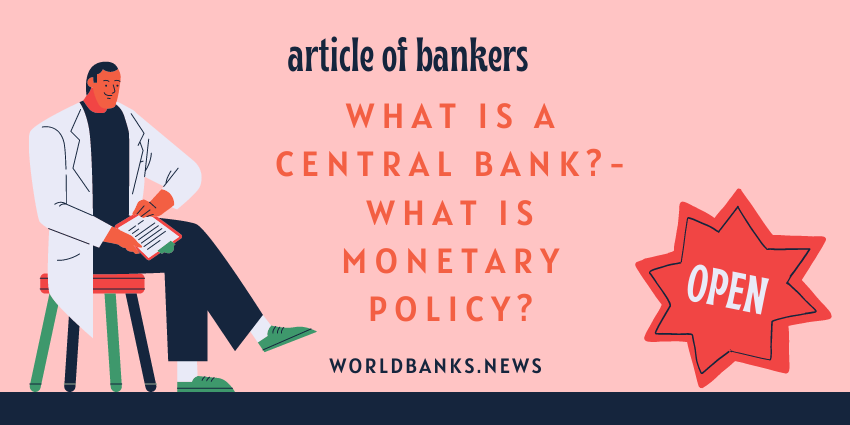What is a Central Bank?-What is Monetary Policy?
Central Banking and Monetary Policy Concepts:
What is a Central Bank?
A central bank central bank is an institution that issues currency, regulates money supply, controls interest rates, oversees financial market and financial system stability and operations. Many central banks also have an oversight role for the banking industry in their jurisdiction; having input into policy and regulations and the implementation thereof. Central Banks may also be referred to as: Reserve Banks, Monetary Authorities, State Banks, and National Banks.
What is Monetary Policy?
Monetary Policy is a process whereby the central bank or monetary authority of a country controls and adjusts the supply of money, in conjunction with tools such as interest rate targets, required reserve ratios, currency measures, etc. The goal of monetary policy is usually focused on maintaining stability; both economic stability and price stability. Monetary policy often contends with the contrasting goals of economic growth, low inflation, and optimal employment.
Monetary policy settings are usually referred to as either ‘expansionary’ or ‘contractionary’. Expansionary monetary policy settings are where monetary conditions are easy, e.g. low interest rates, expansionary settings encourage growth and are often implemented to counter recessions and unemployment. Contractionary conditions are when monetary policy is tighter, e.g. higher interest rates, and are often implemented to act against inflationary pressures, or rising prices.
Central Banking and Monetary Policy Terminology:
Interest Rate
The interest rate is the rate at which interest is paid by a borrower for the use of money that they borrow from a lender. Many central banks set a target, or official, interest rate as part of the implementation of monetary policy. Examples of such interest rates include: Fed Funds rate (US Federal Reserve), Official Cash Rate (RBNZ), Bank Rate (Bank of England), Refinancing Rate (Central Bank of Russia). See our listing of global central bank interest rates.
Required Reserve Ratio
The required reserve ratio or cash reserve ratio is the amount of minimum cash and reserves that the central bank requires commercial banks to hold (rather than lend out) as a proportion of customer deposits and notes. In essence, it limits how much the bank can lend; thus by altering the level of the ratio the central bank can influence the growth of credit which can be important in influencing the level of inflation and economic activity. Required reserve ratios are more commonly used in developing countries and emerging markets, e.g. the People’s Bank of China, Central Bank of Russia, Central Bank of Brazil. top
Inflation Target
Central banks often operate monetary policy with a goal of price stability, or controlling the rate of inflation in a country. As such many banks have official hard or soft inflation targets. Some banks have targets of a specific number, or a cap level, while other banks target an inflation range; recognising that a small amount of inflation may be better than the risks of deflation, in the context of minimising inflation and maintaining price stability. See our listing of central bank inflation targets.
Quantitative Easing
Quantitative easing is the process by which a central bank or monetary authority purchases financial assets from banks and other institutions with new electronically created money. The effect of this is is an increase in excess reserves of banks, and an increase in the prices of the assets bought; which results in a lower market yield. Quantitative easing is considered an unconventional monetary policy tool. Examples of its use include: Bank of Japan (multiple times), the US Federal Reserve and the Bank of England (following the global financial crisis).
Open Market Operations
Open market operations (OMO) are when the central bank conducts transactions in the bond market. Typically the central bank will buy or sell government bonds or bills, as they are often the most liquid instrument and have the highest credit quality, and as such most financial institutions will have a portfolio of such securities. The purpose of open market operations is increase or decrease the monetary base, for example when the bank buys a bond it is purchasing an asset in exchange for cash; this is said to be an injection of cash into the system; similarly when the bank sells securities it transfers the assets to the buyer which pays the bank with cash, thereby removing cash from the system. The basic premise of these operations is that the size of the monetary base is linked to inflation (i.e. more cash in the system should lead to higher prices, holding all else constant).
Money Supply
The money supply (also known as money stock) refers to the total amount of money available in an economy at a given point. Money supply is often talked about in terms of its particular measures:
M0 = Notes and coins in circulation and in bank vaults
MB = M0 plus minimum reserves and excess reserves of banks (referred to as the monetary base)
M1 = Notes and coins in circulation, traveler’s checks, demand deposits and other checkable deposits
M2 = Money and close substitutes for money, a broader classification of money, this includes M1 plus savings deposits and time deposits; M2 is a key economic indicator because of its historical link with inflation
M3 = M2 plus large time deposits, institutional money market funds, short-term repos and other larger liquid assets
MZM = Money with zero maturity, it encompasses financial assets redeemable at par on demand
The money supply is an important facet of central banking and monetary policy, as monetary policy can be implemented through targeting money supply levels, or by targeting an interest rate level (which may be reached by influencing the money supply). The growth in the supply of money is understood to move with and influence the level of inflation and economic growth.
Repurchase Agreement (Repo)
A repurchase agreement (repo) is a transaction involving the sale of an asset (e.g. a bond) with the subsequent repurchase of that same asset for a slightly higher price. Repurchase operations are usually undertaken as a means of borrowing money; using the bond as collateral, as such the price differential is effectively the borrowing interest rate. Central banks frequently engage in repurchase (asset seller = borrower) and reverse repurchase (asset buyer = lender) transactions as part of their Open Market Operations; as a means of injecting or withdrawing liquidity from the system. Central banks often adjust their official/target repo and reverse repo rates as a means of influencing the costs/benefits of borrowing/lending by financial market participants and institutions.
Discount Window
The discount window refers to a mechanism whereby eligible institutions (financial institutions, commercial banks) borrow money from the central bank, typically on a short term basis (and typically via repurchase and reverse repurchase agreements); and usually as a means of meeting temporary shortages of liquidity. The interest rate charged on such loans is called the discount rate (also referred to as the base rate or repo rate). The discount window is a key tool in promoting financial market and banking system stability, particularly when money markets tighten, as in times of crisis e.g. the US Federal Reserve discount window saw considerable use during the 2008-9 financial crisis. The term discount window originated from when bank
representatives physically visited the reserve bank when the bank needed to borrow money. In the eurozone, the European Central Bank (ECB) operates an equivalent mechanism called Standing Facilities; with the Marginal Lending Facility available for short-term bank funding, and the Deposit facility as a means for depositing excess funds.




















